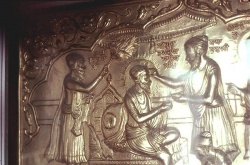Tilak
In Indian culture, a tilak or tilaka is a mark (normally saffron or red in colour) worn on the forehead. It is a mark that is applied at the "Ajna Chakra", the space between the two eyebrows. Today, the Tilaka can be worn on a daily basis or for special religious occasions depending on different local customs. It is normally made from sandal paste or kumkum (red tumeric).
In early Sikhism, the tilak was placed on the forehead of the Guru as a sign of his ascendancy to guruship, the spiritual leadership of the Sikhs. Bhai Buddha was a devoted disciple of Guru Nanak, the founder Sikh Guru. Such was the eminence he had attained in Sikh piety that, at the time of the installation of Bhai Lahina as second Sikh Guru, (named Guru Angad upon installation, (Nanak II)), Guru Nanak asked Bhai Buddha to apply the ceremonial tilak on Bhai Lahina's forehead.
In the past, tilaks were usually worn by priests, ascetics, or worshippers, and other holy people. It symbolize the third eye, or mind's eye, that is associated with the idea of a different perception of the world which is focussed on the spiritual angle of life as opposed to the purely materialist vision which is perceived by the physical eyes.
- See Wikipedia article on Tilak for more information

